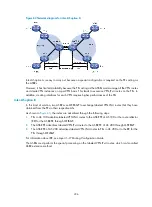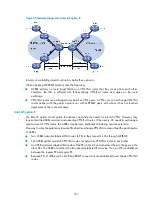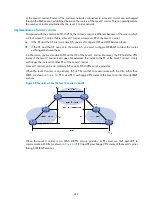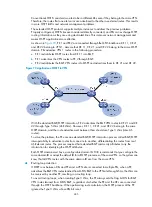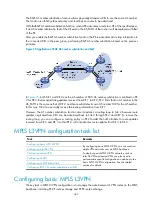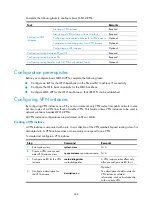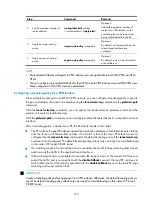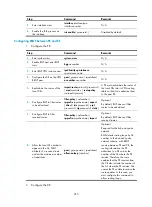
245
Conventional OSPF considers two sites to be in different ASs even if they belong to the same VPN.
Therefore, the routes that one site learns are advertised to the other as external routes. This results
in more OSPF traffic and network management problems.
The extended OSPF protocol supports multiple instances to address the previous problems.
Properly configured, OSPF sites are considered directly connected, and PEs can exchange OSPF
routing information as they are using dedicated lines. This improves network management and
makes OSPF applications more effective.
As shown in
, PE 1 and PE 2 are connected through the MPLS backbone; CE 11, CE 21,
and CE 22 belong to VPN 1. Assume that CE 11, CE 21, and CE 22 belong to the same OSPF
domain. PEs advertise VPN 1 routes in the following procedure:
a.
PE 1 redistributes OSPF routes from CE 11 into BGP.
b.
PE 1 advertises the VPN routes to PE 2 through BGP.
c.
PE 2 redistributes the BGP VPN routes into OSPF and advertises them to CE 21 and CE 22.
Figure 73
Application of OSPF in VPN
With the standard BGP/OSPF interaction, PE 2 advertises the BGP VPN routes to CE 21 and CE
22 through Type 5 LSAs (ASE LSAs). However, CE 11, CE 21, and CE 22 belong to the same
OSPF domain, and the route advertisement between them should use Type 3 LSAs (inter-AS
routes).
To solve the problem, the PE uses an extended BGP/OSPF interaction process called BGP/OSPF
interoperability to advertise routes from one site to another, differentiating the routes from real
AS-External routes. The process requires that extended BGP community attributes carry the
information for identifying the OSPF attributes.
Each OSPF domain must have a configurable domain ID. H3C recommends that you configure the
same domain ID or adopt the default ID for all OSPF processes of the same VPN, so the system can
know that all VPN routes with the same domain ID are from the same VPN.
•
Routing loop detection
If OSPF runs between CEs and PEs and a VPN site is connected to multiple PEs, when a PE
advertises the BGP VPN routes learned from MPLS/BGP to the VPN site through LSAs, the LSAs can
be received by another PE, resulting in a routing loop.
To avoid routing loops, when creating Type 3 LSAs, the PE always sets the flag bit DN for BGP
VPN routes learned from MPLS/BGP, regardless of whether the PE and the CEs are connected
through the OSPF backbone. When performing route calculation, the OSPF process of the PE
ignores the Type 3 LSAs whose DN bit is set.






